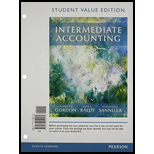
a.
The criteria of determining the carrying value of accounts receivables.
b.
Factors influencing managerial decision in estimation of amount of collectible receivables.
c.
Percentage of trade receivables to total assets.
Given information:
Trade receivables for year 2013 are $1,424 and for year 2012 are $1,454.
Total assets for year 2013 are $15,474 and for year 2012 are $15,169.
d.
Percentage of the allowance for uncollectible accounts to total trade receivables.
Given information:
Total trade receivables for year 2013 are $1,231 and for year 2012 are $1,185.
Allowance for uncollectible accounts for year 2013 is $5 and for year 2012 is $6.
e.
Write-offs of accounts receivables.
Given information:
Opening balance of allowance is $6 and $8 for year 2013 and 2012 respectively.
Additions charged to expense are $2 and $1 for year 2013 and 2012 respectively.
Doubtful accounts charged to reserve are $3 and $3 for year 2013 and 2012 respectively.
Want to see the full answer?
Check out a sample textbook solution
Chapter 9 Solutions
Intermediate Accounting - Myaccountinglab - Pearson Etext Access Card Student Value Edition
- During FY 2021 GE Production had total manufacturing costs of $583,000. Their cost of goods manufactured for the year was $527,000. The January 1, 2022 balance of Work-in-Process Inventory is $92,000. Use this information to determine the dollar amount of the FY 2021 beginning Work-in-Process Inventory.arrow_forwardI need help with this general accounting problem using proper accounting guidelines.arrow_forwardHi expert please given correct answer with accounting questionarrow_forward

 AccountingAccountingISBN:9781337272094Author:WARREN, Carl S., Reeve, James M., Duchac, Jonathan E.Publisher:Cengage Learning,
AccountingAccountingISBN:9781337272094Author:WARREN, Carl S., Reeve, James M., Duchac, Jonathan E.Publisher:Cengage Learning, Accounting Information SystemsAccountingISBN:9781337619202Author:Hall, James A.Publisher:Cengage Learning,
Accounting Information SystemsAccountingISBN:9781337619202Author:Hall, James A.Publisher:Cengage Learning, Horngren's Cost Accounting: A Managerial Emphasis...AccountingISBN:9780134475585Author:Srikant M. Datar, Madhav V. RajanPublisher:PEARSON
Horngren's Cost Accounting: A Managerial Emphasis...AccountingISBN:9780134475585Author:Srikant M. Datar, Madhav V. RajanPublisher:PEARSON Intermediate AccountingAccountingISBN:9781259722660Author:J. David Spiceland, Mark W. Nelson, Wayne M ThomasPublisher:McGraw-Hill Education
Intermediate AccountingAccountingISBN:9781259722660Author:J. David Spiceland, Mark W. Nelson, Wayne M ThomasPublisher:McGraw-Hill Education Financial and Managerial AccountingAccountingISBN:9781259726705Author:John J Wild, Ken W. Shaw, Barbara Chiappetta Fundamental Accounting PrinciplesPublisher:McGraw-Hill Education
Financial and Managerial AccountingAccountingISBN:9781259726705Author:John J Wild, Ken W. Shaw, Barbara Chiappetta Fundamental Accounting PrinciplesPublisher:McGraw-Hill Education





